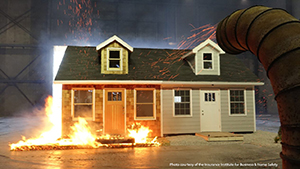 In 2009, a massive wildfire swept across eastern Horry County near Myrtle Beach. It burned 19,000 acres, destroyed 76 homes, forced the evacuation of more than 4,000 residents and resulted in $25 million in property damage and $17 million in agricultural damage. This fire serves as a powerful reminder that wildfires don’t just happen in western states like California; South Carolina is also vulnerable.
In 2009, a massive wildfire swept across eastern Horry County near Myrtle Beach. It burned 19,000 acres, destroyed 76 homes, forced the evacuation of more than 4,000 residents and resulted in $25 million in property damage and $17 million in agricultural damage. This fire serves as a powerful reminder that wildfires don’t just happen in western states like California; South Carolina is also vulnerable.
Researchers at the Insurance Institute for Business & Home Safety (IBHS) have been conducting important research on how to prevent and reduce property damage caused by wildfires. As a member company of IBHS, Farm Bureau Insurance® is proud to support this research so that we can provide the most up-to-date information to our member-policyholders on how to best protect homes from wildfires and other severe weather events.
In March 2019, at the IBHS Research Center in Chester County, researchers demonstrated how simple building methods and fire-resistant materials can make the difference in whether a home is ignited by a wildfire’s wind-borne embers. Inside the test chamber, more than 100 fans blew embers toward a full-size duplex that was built using different materials and construction methods. One side was deemed high-risk for fire due to the materials used: cedar-shingle siding, vinyl gutters, single-pane windows and wood chip mulch around the foundation. The other side was built using fire-resistant materials like fiber-cement siding, metal gutters, multi-pane windows and rock mulch around the foundation.
“It’s all about the embers and making sure they have nothing combustible to land on,” said Daniel Gorham, P.E., wildfire researcher at IBHS. “Embers can fly for miles ahead of the wildfire front. If they get inside a home through vents or an open or broken window, or if they land on dead vegetation, dry wood, or combustible materials near the home, they can ignite a new fire which can then consume that home and start a chain of fires within a neighborhood or community.”
Within ten minutes of starting the test, the wood chip mulch on the high-risk side ignited as embers landed on combustible landscaping. Flames spread up the side of the building and into the open eaves. The high-risk side was engulfed by flames, while on the other side, the wildfire resistant portion of the structure did not burn at all.
The lessons learned from this IBHS demonstration reinforce practical, affordable steps a homeowner can take to defend their home against wildfire. It boils down to two things: maintenance and materials.
Ten Ways to Protect Against Wildfire
- Maintain a Five-foot Noncombustible Zone: Use noncombustible materials such as gravel, brick or concrete in this critical area including under decks.
- Reduce siding risks: Maintain six-inch ground-to-siding clearance and consider noncombustible siding.
- Clean Debris from Roof: Regularly remove debris from your roof, since debris can be ignited by wind-blown embers.
- Class A Roof Covering: Class A fire-rated roofing products offer the best protection for homes.
- Clean Out Gutters Regularly: Keep debris out of gutters since debris can be ignited by wind-blown embers. If used, gutter covers should be noncombustible.
- Reduce Fence Risks: Burning fencing can generate embers and cause direct flame contact to your home. Use noncombustible fences and gates.
- Keep Embers out of Eaves and Vents: Use 1/8-inch mesh to cover vents and box-in open eaves to create a closed eave with soffits.
- Protect Windows: Use multi-pane, tempered glass windows and close them whenever a wildfire threatens.
- Reduce Desk Risks: At a minimum, use deck boards that comply with California requirements for new construction in wildfire-prone areas, remove combustibles under a deck and maintain effective defensible space.
- Maintain Defensible Space: Within 5-to-30 feet of your home, remove shrubs under trees, prune branches hanging over your roof, thin trees and remove dead vegetation. Move trailers/RVs and storage sheds from the area, or build defensible space around these items.
For more tips on how to create a disaster-resistant home, visit the Catastrophe Planning section of our website as well as the IBHS website. Also, be sure to sit down with your local Farm Bureau Insurance agent to review your homeowner’s policy. While we hope disaster never strikes close to home, it’s always a good idea to review your coverage periodically.